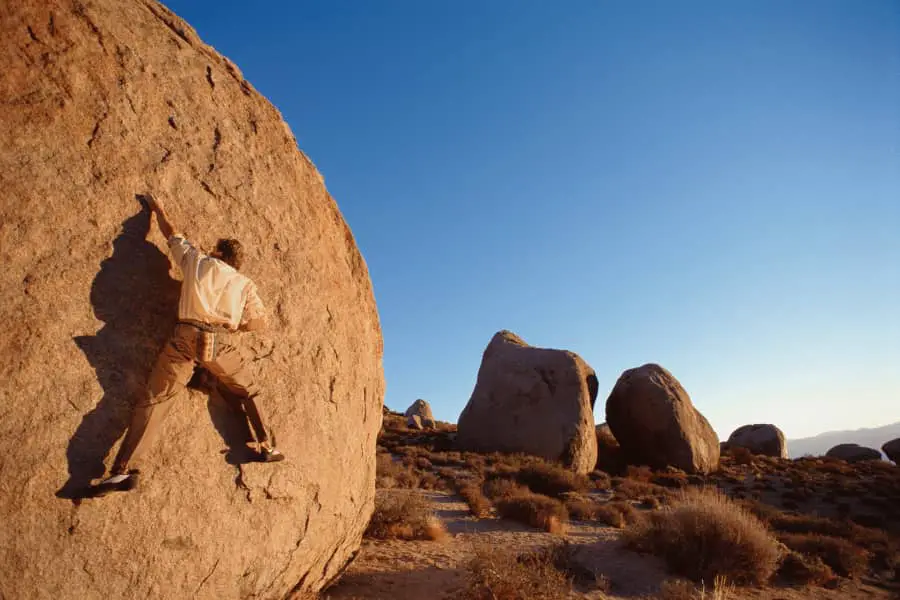
When I first went bouldering outdoors I had no idea what to bring with me. Luckily my friends were experienced and were able to help me pick out what I needed. I put together a list that included everything you could possibly want for an outdoor bouldering trip.
When bouldering outdoors you need to bring your climbing shoes, crash pads, chalk, water, towels, and a brush. Additional helpful items to bring include snacks, flip flops, headlamps, sunscreen, bug repellent and athletic tape.
If you are interested in seeing what the current prices are for the most popular rock climbing shoes, you can find them on Amazon by clicking here. Using the Amazon affiliate link above and/or other links in the article helps support this website.
Below is the ultimate list of all 21 items that you could want when bouldering outdoors.
1. Approach Shoes
Bringing approach shoes with you is an absolute necessity when bouldering outdoors. You will not want to walk up to the route in your climbing shoes as it will hurt your feet and ruin your shoes.
Some people may opt to approach the boulders barefoot but this can end your planned fun day of climbing early if you cut open your foot on the sharp rocks or twist an ankle. I recommend wearing a pair of hiking or athletic shoes to approach where you will be climbing. These will be sufficient for the majority of places where you will be bouldering.
If you will be climbing in more isolated areas or areas harder to get to that involve boulder hopping, it will be useful to pick up a pair of approach shoes. Approach shoes are designed to be functional and provide climbers with exceptional grip when handling rocky and uneven terrain.
2. Climbing Shoes
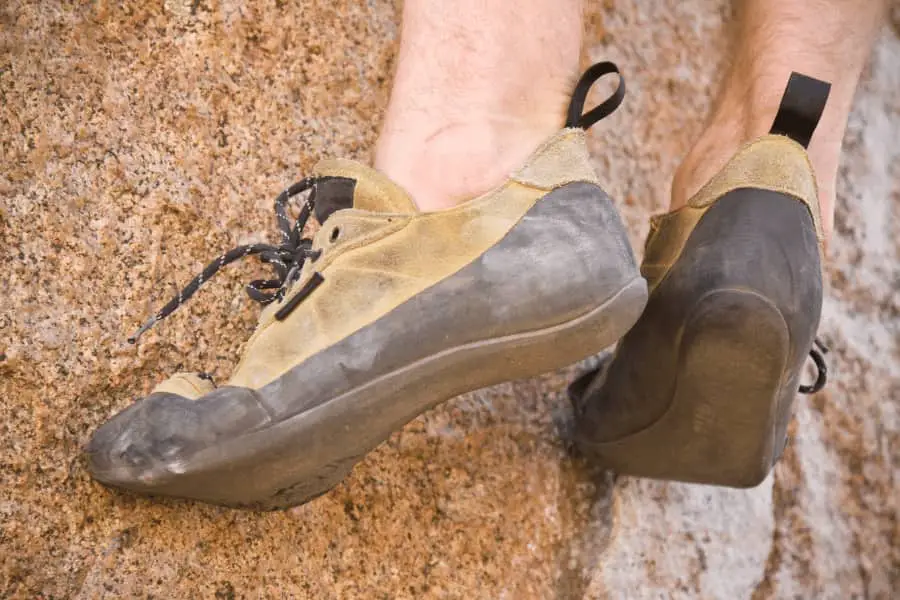
This should be self explanatory. You will be climbing; therefore, you will want to bring your climbing shoes with you. If you do not own a pair of climbing shoes and plan to climb regularly, I highly recommend you pick up a pair. They allow you use tiny footholds on the rock and will have you feeling like Spiderman.
If you are looking at either your first pair of climbing shoes or looking to get a new pair, I suggest you check out my favorite climbing shoes linked here! I go into an in depth review of my favorite shoes for beginner, intermediate, and advanced climbers alike.
Although it is definitely not recommended, some climbers opt to go barefoot. While this is more dangerous and way harder than using shoes, it comes with a few advantages as well. If you want to know more about climbing barefoot, you can check out the article I have linked here after you finish learning about what gear you will need.
3. Chalk
Another climbing essential, chalk will wick away the moisture on your fingers and give you better grip on the rock. I have found my favorite item to use when bouldering outdoors is a chalk bucket. These are really cool and create a fun atmosphere from the start.
Chalk buckets are ideal for groups because they are absolutely massive. They are designed to sit on the ground and are not meant to be attached to the climbers when climbing. Because bouldering problems are short, you will not need to reapply chalk in the middle of the problem.
It is always fun to huddle around the chalk bucket and hang out whenever there is down time.
4. Brush
Brushes are great at cleaning the holds. They remove all excess dirt and chalk build up along the route. This will help you get more friction when climbing and will prevent you from slipping off easily. These are definitely worth picking up if you do not already have one.
For those of you wondering, no… this is not the same as a tooth brush. These brushes have sturdier and more heavy duty bristles. This allows for a deeper and better cleaning of the holds. If you wish to bring a toothbrush along go ahead. Just don’t use it on the rock.
5. Crash Pads
Crash pads are another outdoor bouldering essential. These (quite literally) are lifesavers. Unlike climbing gyms, the ground of the great outdoors is not made of soft foam padding. Thats where these babies come in.
Crash pads are boulderers best friends when used properly. Always be sure that you are placing your crash pad correctly so that it is underneath the fall zone of the climber. Be sure to eliminate any gaps between multiple crash pads and lay them out on level surfaces.
If you are interested in seeing what the current prices are for the most popular crash pads, you can find them on Amazon by clicking here. Using the Amazon affiliate link above and/or other links in the article helps support this website.
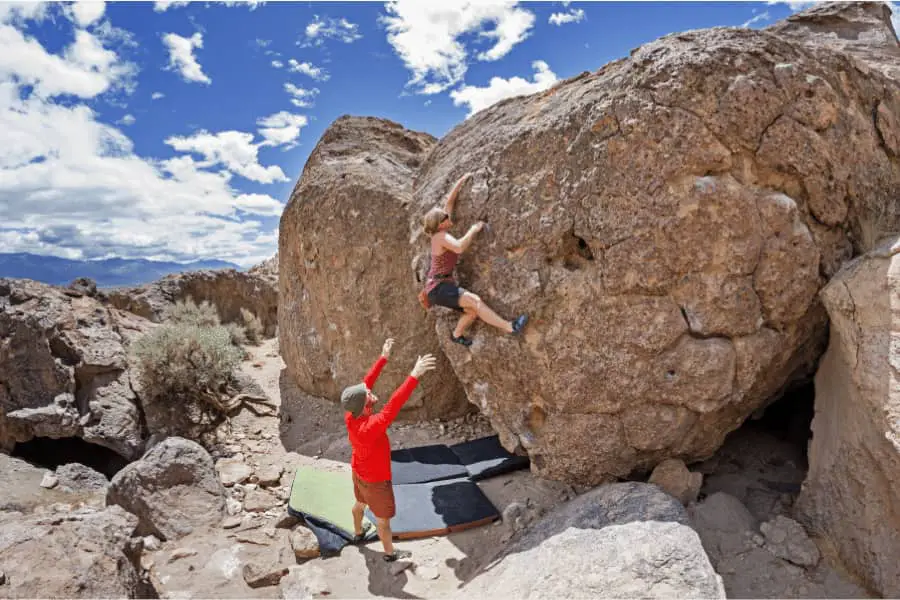
If you have never used a crash pad before, I wrote an article detailing 11 tips on how to use them properly. I definitely recommend checking that out before going on your first outdoor bouldering trip. You can find that article linked here.
6. Chairs
Bouldering outdoors is just as much a social outing as well as it is a climbing session. There will be downtime when everyone is tired or just needs a break. While sitting on the ground or the pads is fine, bringing a chair along might save your butt or back.
It may be helpful to think of bouldering outdoors as a mini camping trip with climbing mixed in. If you have camping chairs, they can save you from having to sit on rocks or logs. While that may not seem so bad, it can get annoying being constantly uncomfortable when you are bouldering for long periods of time.
7. Towels or Rags
Towels and rags are used to wipe off the route before brushing it and to wipe off your shoes. While brushes are great at clearing the fine dirt and chalk build up off the holds, they are not so great at clearing large amounts of junk off. Thats where towels and rags come in. You should wipe off the route with towels and rags first to get all the major junk off of them.
In addition to this, you can use these same towels and rags to wipe off your shoes before getting on the boulder. Because you will be outside, your shoes will pick up dirt and dust. This dirt and dust build up will reduce the amount of grip your shoes will have on the problem. Simply wiping this off with a towel or rag will take care of that issue.
8. Flip Flops
When you are lounging around the rock, it will be nice to have a comfortable pair of flip flops or sandals along. While climbing shoes are great at helping you get up the wall, they sure aren’t made for comfort. Sandals will give your feet a much needed break from your climbing shoes.
Although you will have your approach shoes with you, it will be nice to air out your feet and let them breathe in your nice pair of flip flops. Plus.. putting socks and shoes on seems like a lot of work when you don’t need to do so.
9. Water
Climbing is a cardiovascular activity and requires a lot of energy to do. As with all cardio, dehydration can sneak up on you really quick. One minute you will be having fun climbing around, the next your drenched in sweat and parched.
It is always a good idea to bring water with you if you will be bouldering for any extended period of time. In an effort to leave no trace, I recommend using a re-usable Nalgene bottle. Not only will it limit waste, but you can add a whole bunch of cool stickers to it to personalize your bottle.
There will never be a time that you regretted bringing water with you. However, there would be plenty of times that you would regret not bringing any. As my mother always says, better safe than sorry.
10. Athletic Tape
Athletic tape is used to tape your fingers when climbing. Rock edges can be sharp and cut into your fingers. Tape helps prevent this from happening. In addition to this, tape helps keep your skin intact when climbing. Rock will rip away your skin and make your fingers and hands raw. Tape is great at preventing that.
Overtime you will start to develop calluses on your fingers. Calluses are build ups of dead skin. These will also help prevent your hands from getting torn up by the rock.
11. First Aid Kit
A basic first aid kit will help you be prepared for minor injuries that may occur. Climbers may cut open their fingers on the rock or scrape their knees. These are minor injuries and are somewhat common amongst newer outdoor climbers from what I have noticed. Having a first aid kit with antiseptic ointment and bandaids will go a long way.
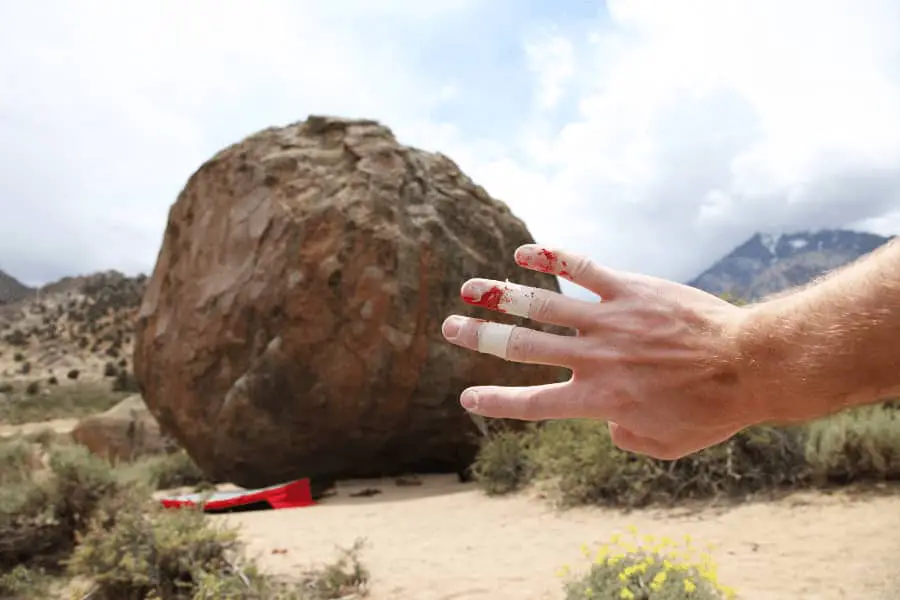
I recommend at least brushing up on first aid for climbing injuries you may encounter such as scrapes, sprained ankles, and even broken bones. Hopefully you will never have to use that knowledge. That is something you need to know but never want to use. Thankfully the only injuries I have seen while bouldering have been minor (cuts on fingers and scraped knees).
12. A Headlamp
Headlamps are great for night climbing and for transporting all of your gear back to the car. If you will be climbing at night, you will not want to have someone hold a flashlight the entire time. Instead, it is much easier to get a headlamp so you can light up the route hands free.
If you plan to only climb during the daylight, headlamps can still be beneficial for the walk back to the car. You will be carrying a lot of gear back to the car and will want all of your hands for that. If you are leaving as it is getting dark out, a headlamp will light up your walk back hands free.
13. Climbing Pants
Climbing outside is much different than climbing indoors. If it is your first time climbing outdoors then I recommend wearing a pair of climbing pants. Climbing pants are flexible, lightweight, and breathable. These will prevent your knees from getting scraped up on the rock and won’t limit your movement.
If you do not want to get a pair of climbing pants, you can wear blue jeans or athletic pants. Just know that blue jeans may get hot and may limit your movement. Athletic pants won’t limit your movement but may get torn up on the rock. Be mindful when choosing what pair of pants to wear.
14. Extra Clothing
Extra clothing is great incase it rains on you or it starts to get cold out. If the forecast looks like it may call for rain, having an extra pair of dry clothes to change into at the end of the day will feel fantastic. If you are curious about climbing in the rain, I wrote an article about it linked here.
If it starts to get cold out, layering up on clothes will help to keep you warm. That…and climbing more!
15. Snacks
This is probably my favorite item on this list. who doesn’t love snacks!? You will most likely get hungry after spending awhile bouldering. Because climbing is such a great full-body workout, it burns a ton of calories.
It is up to you how you want to replace these calories. You can either bring healthy snacks like fruit and Clif bars or you can bring unhealthy healthy snacks like chips and candy. It’s your choice but I think a combination of the two will always be a good decision.
16. A Speaker
As mentioned previously, bouldering outdoors is a fun social event too! It can be awesome to bring a speaker and play some catchy tunes while hanging out. Music will create a much more fun and lively atmosphere when you are out there and can keep spirits high.
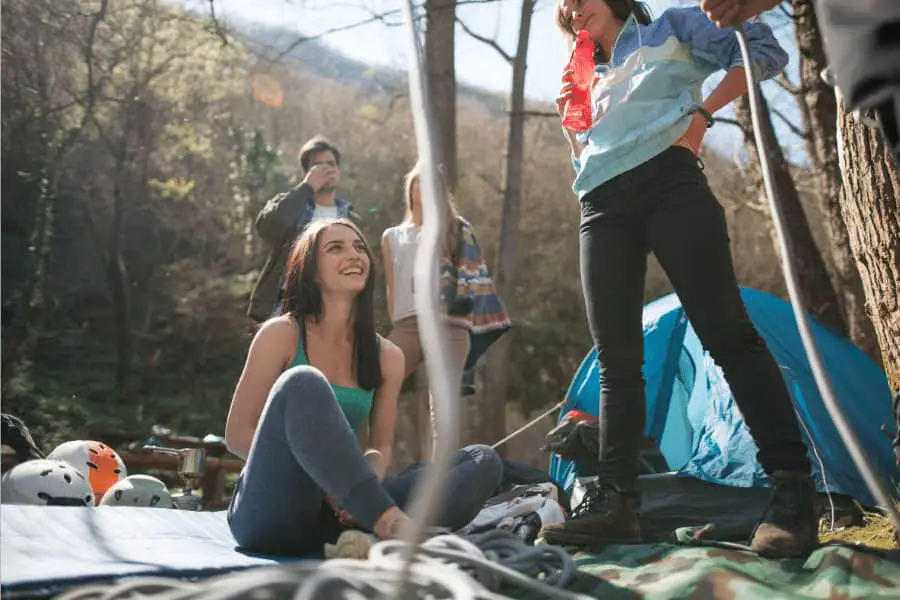
The trick is finding music that everyone will enjoy. I recommend putting together a couple of different playlists and having them at the ready just incase someone isn’t a fan of a certain music genre.
I have found that most climbers I have met enjoy alternative, classic rock, and reggae. Steer clear of the country music unless you know your climbing buddies will enjoy it. (I personally love country music but have been asked to change the songs more times than I can count).
17. Blankets
Blankets are great for the colder seasons climbing. When you are lounging around and hanging out it is nice to cozy up in a snuggly blanket. On top of this, it will help keep your muscles warm. Keeping them warm will help you stay loose and ready to climb at a moment’s notice.
Blankets can also be put on top of crash pads when lounging around. This will help prevent any dirt or anything from getting on you or your clothes. However if you ware worried about getting dirty, climbing outside may not be the activity for you. Climbers are lovingly referred to as dirt bags for a reason.
18. Sunscreen
It only took making this mistake once for me to never make it again. I went on a bouldering outing that I thought would only last a few hours. It turns out the expedition lasted the entire day. No one brought sunscreen with us and oh man did we pay the piper.
It was at the very start of summer so sunscreen wasn’t at the forefront of our minds yet. Well I sure wish it was. After being outside for 8 hours with no sun protection, we were all bright red. That was the worst sunburn I have ever had in my life. My shoulders even started to blister up a few days later.
Don’t be like us. Wear sunscreen. You can get sun burnt easier than you think. It doesn’t take 8 hours of direct exposure to make you sting the next day.
19. Insect Repellent
Bugs are a thing! If you know you will be in a forested area or nearby water I highly recommend bringing bug spray along just incase. Mosquitoes get quite bad up here in Wisconsin and I’m sure they do in other spots as well. Sweating naturally attracts them and trust me, if you are climbing in the summer, you will be sweating.
Investing in a good insect repellent can be a life saver. If you don’t use it, no big deal. But if you are getting eaten alive by bugs and don’t have one, you’ll wish you did.
20. A Guidebook
Guidebooks can be beneficial in helping you identify local routes in the area and can provide some helpful information on them. However, try not to rely on these books too much as they can make a fun session not so fun. It is better not to stress out about doing exactly everything detailed in the book.
I have found that the most fun we have had bouldering was when we were creating out own beta and routes. If you see something that looks like it would be fun to try and climb… climb it! Try not to worry about grades or the correct beta too much when you first start bouldering outside. Just go and enjoy the experience.
21. Backpack
Now that you have all of these great items to bring with you, you wil need a way to carry them. There is no need to buy any fancy climbing bag or climbing backpack if you are just going out bouldering with a few friends. A simple backpack, duffle bag or sling bag will do. Literally anything you can find laying around your house.
Transporting a backpack and crash pad at the same time may be tricky for you. I recommend wearing the backpack as a “frontpack” and the crash pad on your back as normal. If you try to wear the crash pad on your front then you won’t be able to see a dang thing.
The bottom line? Bouldering outdoors is a fantastic time especially if you have a large group going! At a minimum you will need to bring your climbing shoes, chalk, crash pad, brush, towels and water. You can take your outdoor bouldering experience to the next level by bringing a speaker, chairs, flip flops, a head lamp and athletic tape.
